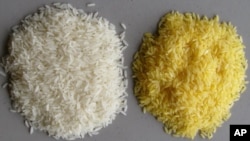Excessive regulation of genetically modified crops has delayed release of a variety of rice that could help reduce the leading cause of preventable blindness in children, according to an editorial published in the British journal Nature.
Vitamin A is essential for vision and a healthy immune system. The World Health Organization estimates that at least 250,000 children go blind each year from vitamin A deficiency, and half of them die within a year of losing their sight.
Rice doesn't naturally contain this essential nutrient. That's why vitamin A deficiency is so common in parts of Africa and Southeast Asia, where rice is the mainstay of the diet.
Making rice golden
To tackle the problem, researchers took genes involved in producing beta carotene, a vitamin A precursor, from other plant species and inserted them into rice. It gives the rice grains a yellow-orange color, and their name: Golden Rice.
When the project began in 1990, it was considered unlikely to succeed, says Golden Rice's co-inventor, Ingo Potrykus, a retired professor of plant sciences at the Swiss Federal Institute of Technology.
"It was considered far too ambitious because you had to transfer an unknown number of genes — at least six different genes — into rice. At that time people were happy to transfer a single gene."
Potrykus says they had succeeded by 1999, but it will be 2012 at the earliest before Golden Rice is available to people who need it. He blames the delay on excessive regulation. He says an unreasonable amount of testing has been required, without scientific justificiation.
'Death and blindness'
"I therefore hold the regulation of genetic engineering responsible for the death and blindness of thousands of children and young mothers," he writes in the Nature editorial.
Potrykus wants the regulations changed because research institutes around the world are working on other important GM crops besides Golden Rice that could also help feed people in the developing world. However, he says, because bringing them to market takes 10 years longer and costs 10 times as much as a conventional crop, these crops are languishing on the shelves. He says now that some GM crops have been grown successfully for more than a decade, it's time to loosen the restrictions.
"Despite claims of high risk of this material," he says, "there is not a single documented case of harm to any environment or any consumer."
'Scientific garbage'
Doug Gurian-Sherman, with the environmental group the Union of Concerned Scientists, calls that argument "scientific garbage." He says you can't say GM crops are safe because no one's really done a large-scale epidemiological study to see how people's bodies respond to them. He says they may very well be safe. But that won't be clear until they are tested.
"Potrykus' argument is like saying, 'Well, we've got these wonder drugs that could cure AIDS or cure malaria or cure whatever," says Gurian-Sherman, "but let's not do any testing on them because there's people suffering in the meantime.'"
Gurian-Sherman says one reason Golden Rice needs to be tested for safety is because vitamin A and its chemical relatives can be toxic at high levels.
Carrot poisoning
Others don't see that as a convincing argument.
"It's like saying if you ate too many carrots you could get vitamin A poisoning. It just doesn't happen," says Howarth Bouis, director of a project called Harvest Plus, which is working to breed more nutritious crops for the developing world.
Bouis is on the board of the Golden Rice project. But he says Harvest Plus decided to stay away from using GM technology because regulations would slow progress.
"I think we're going to make some good progress with conventional breeding that we couldn't have made with transgenics simply because of the regulatory systems in place."
For example, researchers are developing vitamin A-rich maize using conventional breeding. While regulators require extensive testing on GM Golden Rice, the new fortified maize varieties won't raise an eyebrow.
Doug Gurian-Sherman of the Union of Concerned Scientists says GM technology is inherently more costly and time-consuming than conventional breeding. He would prefer to see more of the limited resources available for agriculture research spent on conventional means of tackling malnutrition. But if tests show Golden Rice is safe and effective, he says it should be considered.
The question will be, how much testing is enough?















